Dec 23, 2025
Dec 23, 2025
by Rita Dey
India is in the midst of the government-imposed 2nd Lockdown which was scheduled to be over on 3rd May. For the world’s second most populous country to shut down almost its entire economy and confine its 1.3 billion citizens to their homes for six weeks was indeed a tough call. However, as we move towards the end of this lockdown stage 2 there are now reports of the lockdown being extended for another 2 weeks, and starting relaxation of movements in some areas based on the zone that they are in (Red Zones have a high number of cases and a high doubling rate, Orange Zones have comparatively fewer cases and Green Zones have not had any cases in the last 21 days) [1]
While the administration can set up mechanisms and guidelines for COVID management it is imperative that people themselves adapt to some of the key behaviour and practices. Only then can we expect positive impact from the various measures being advocated by the administration. However, the GoI’s tactics for handling and messaging to combat COVID is being modified almost every day. Keeping track of all messages except for the key ones is almost impossible for common citizens. Our first article Citizens Perceptions of Crisis Messaging During Lockdown Period Stage - I focussed on Citizens comprehension and retention of messages received. Forty plus days onto the lockdown we now look at the behaviour changes adapted and retained by people based on the communication that they have received on COVID.
As in the first stage of lockdown a rapid survey was carried out in the last week of the lock down with a small group of respondents from across India. Responses varied from single to multiple choices. The respondents were from different walks of life and different age groups. The survey probed on peoples’ knowledge of messages as well as their response to behaviour choice / change due to the pandemic during this lockdown stage 2 phase. An attempt was also made to understand if respondents are willing to continue with these adopted practices post lock down. A major limitation of this assessment has been the sample type and the mode of survey. All respondents are literate, tech savvy and represent the socio-economically better off population.
In a pandemic like situation remote messaging is most commonly used. This has a major weakness due to the limitation of access. As in any emergency situation it is obvious that the messages will change and evolve with time as per need and situation. With increased awareness on how COVID behaves there have been shifts in messaging resulting in confusion and often miscommunication or delay in people’s grasping these shifts. Initially, masks were not thought to be necessary equipment for the general public but presently it is being advocated as necessary every time an individual is interacts with others especially when outside of one’s own sanitised environment.
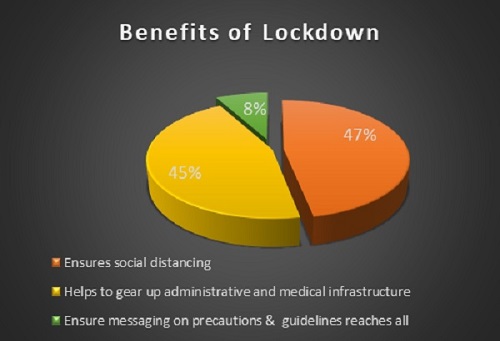
At the moment, we have very little defence in the fight against COVID in a densely populated country like India. The administrations messaging on conduct at the national level or state level has been very clear and simple soliciting every citizen to co-operate by,
The Indian government too like other governments has resorted to introducing lockdown measures in order to prepare people for and accept the above listed behaviours. The lockdown can be regarded as a more targeted approach to contain high risk activities and protect high-risk populations while giving the administration more time to prepare for managing the pandemic.
All respondents were unanimous in their view that lockdown was necessary and implemented to primarily manage the Corona pandemic. 100% attributed containment of Corona infection or breaking the chain of infection as the major benefit of lockdown. 47% felt that a lockdown ensures social distancing is practiced, 45% opined that this period of lockdowns gives the administration time to upgrade the medical infrastructure and gear up the machineries for managing COVID.
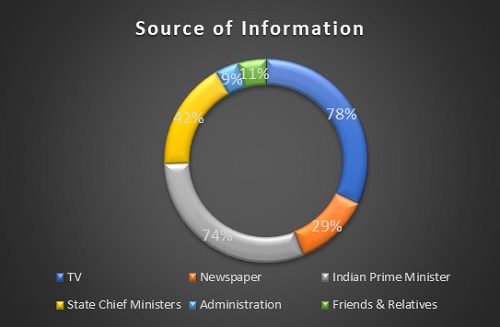
64% had access to multiple sources [2] for information regarding Lockdown. TV was the most common source at 78% while newspapers stood at 29%. Considering that many have stopped subscribing to newspapers this is still a significant percentage. 74% stated that the PM’s speech was a trusted source of information on lockdown followed by the State CMs at 42%. It is noted that the roles played by civic bodies and Police though mentioned did not seem to be an important source.
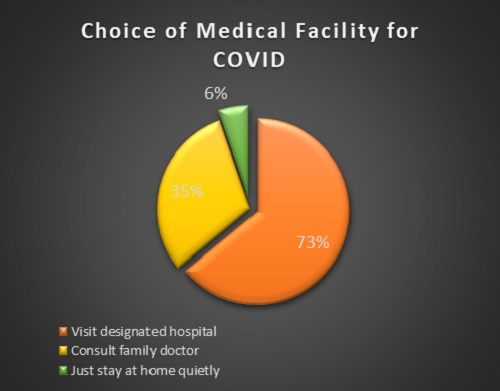
73% respondents were of the opinion that they would need to visit a designated hospital if anyone has COVID like symptoms. 35% also stated that they would like to consult their family doctors who they trust “most”. However, 6% explicitly expressed that they would “just stay at home quietly”. This aspect is of concern as such people are likely to spread the infection more than those who disclose. This seemingly, is the result of the perception related to ostracization associated with COVID as respondents cited cases on refusal of COVID patients by hospitals as also the behaviour meted out to the infected persons of any stature.
People can now conduct a self-assessment of their health status and seek help through the Arogya Setu App on their mobiles, as highly advocated by MoHFW. This mobile application has been developed to help monitor health status and get access to Corona related information (India is estimated to have smartphone penetration of 27.7%). 47% of the respondents stated that they have used this app while 8% who were also users stated that they would like more information about this app. 19% who were non users wanted more information about the App. Clearly the utility of the App has eluded majority of the citizens as its use and benefits have not been communicated well.
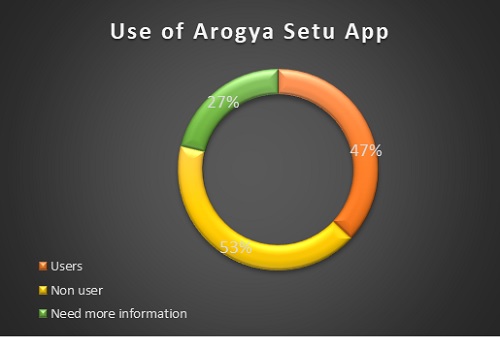
The government has also set up a website wherein all information is being provided with respect to COVID management and care (MyGov Corona Hub). None of the respondents made any mention of the latter.
The Ministry of Health and Family Welfare has also started a state wise helpline number for professional advice on psychological issues including how to manage stress and anxiety during COVID outbreak. The website of the ministry gives insight into psychosocial issues related to Corona. This information is only made available through text messaging to various mobile users. However, not many people seem to be aware of the website or showed any desire to access it.
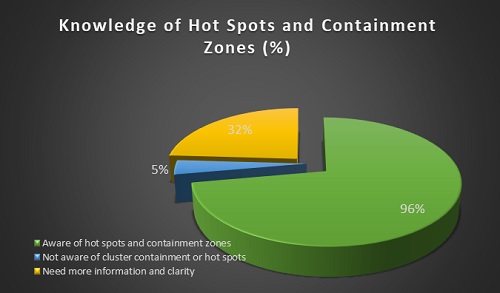
In the second phase of lockdown, the administration identified hotspots and containment zones to pin point specific areas with infected persons. 96% respondents were aware of both the terms hotspot or cluster containment. 5% clearly stated that they don’t know /are not aware of the term ‘cluster containment.’ 32% expressed a desire to get more information and clarity on the ‘two terms’ and the concept behind labelling an area as hotspot or cluster containment zone. Respondents stated that the dynamic nature of zoning of these areas was creating confusion often resulting in sporadic opening of shops and markets and overcrowding which is completely detrimental to the basic principal behind lock down and its extension.
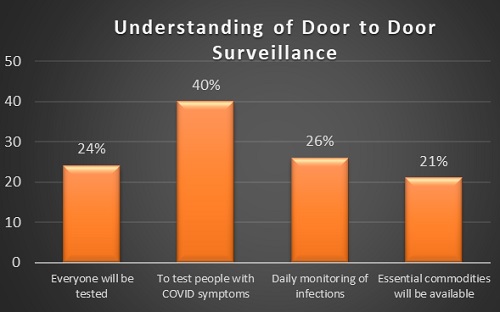
As part of managing infections in the identified hotspots and containment zones, the GoI declared door to door surveillance as one of the measures. 63% were aware that this guideline was specifically meant for containment zones and 40% stated that only people with symptoms would be tested for COVID. In this regard there seems to be confusion with 24% perceiving that everyone would be tested for COVID and 26% stated that this would entail monitoring for infections on a daily basis. 21% felt comfortable that in hotspots and containment zones essential supplies would be available even when other amenities remain closed.
Life under lockdown brings many challenges. Our discussions revealed that there have been many instances of people flouting advice on social distancing or isolation. People don’t seem to comprehend that the more people abide by the advice the more effective the lock down would be. Few of the countries that have implemented full lockdown are committing to a date when they will lift restrictions, but they will need to see how the pandemic evolves. There is no perfectly safe way for India either to come out of its lockdown. None of the expected remedies, treatments or vaccines is in sight. In India are nowhere close to having mass testing capacity nor can we stay locked in forever.
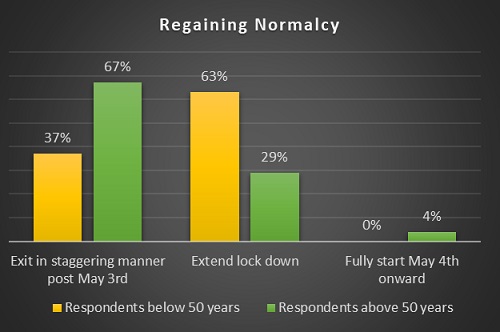
The longer lockdown continues, the economic devastation would become more intolerable, with loss of livelihoods. Even in such circumstances the government is hesitant to come out of the lockdown. A latent fear remains that with relaxation of lock down there will be a spike in COVID infections which will be a set back and reversal of all the efforts taken through lock down so far. In conjunction with this opinion, concerns on disruptions in the economy leading to lowering of GDP, lack of supply of goods and materials and over all lack of development in the country loom making it a vicious cycle. It is felt important that economic activities begin gradually as soon as possible but in careful calibration.
Overall, 52% of the respondents irrespective of age were of the opinion that if required, regular movement and activities would need to be started in a staggering manner post 3rd May while 46% were clear that the lockdown is needed to be extended further. Only 4% felt that everything should be restarted at full throttle May 4th onwards. Interestingly, looking at the ages of respondents, 63% below the age group of 50 were of the opinion that the lockdown is needed to be extended while only 29% of the above 50 looked out for extension of lock down. This is indeed fascinating to note that the younger age group that is more used to being out of their homes be it for work, education or socialising etc realise that lockdown does have the benefit of delaying and slowing down the spread of infection.
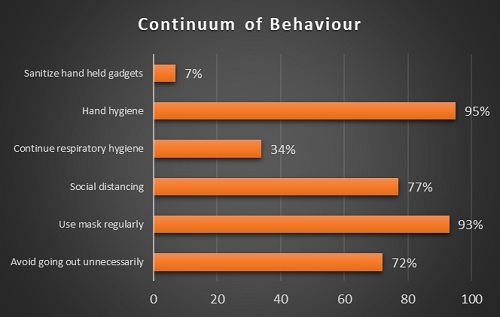
COVID is here to stay as a disease and the required hygiene etiquettes will now need to become regular habits of people. 72% believe that in future too they will need to avoid going out unnecessarily with 54% advocating ‘work from home’ post lockdown. 93% were very clear that masks would need to be used regularly. 77% stated that they would continue to practice social distancing. It is seen from the responses that most people understand the need to continue with safe behaviour post lockdown. However, only 34% stated they would continue with respiratory hygiene by coughing or sneezing into their upper arm. 95% were willing to continue with hand hygiene practices. Only 7% felt the need to clean and sanitise their hand-held gadgets.
Overall, it is interesting to note that people have been able to inculcate several good practices that are being promoted within such a short period. Use of mask for protection and abstaining from venturing outside home unnecessarily along with maintaining social distancing are key practices that majority would like to continue with. However, some of the hygienic etiquettes related to coughing and sneezing and also spitting still need to be driven in that are critically important for preventing Corona infection. There is a feeling of administrative over dose on zoning and their frequent changing which requires clarity to avoid confusion related to mobility. Mobile based Apps and web sites are not accessed to a large extent as their benefits are not understood and there always will remain the limitation of access. Lastly, the concern on accessing hospitals when necessary for COVID and other ailments needs to be absolved as an immediate measure which may otherwise deter people from declaring their medical status.
Footnotes
[1] This classification is multi-factorial and takes into consideration incidence of cases, doubling rate, extent of testing and surveillance feedback to classify the districts
[2] TV, newspaper, PMs speech, Cm’s speech, friends and relatives, Announcements by police or local administration bodies
04-May-2020
More by : Rita Dey